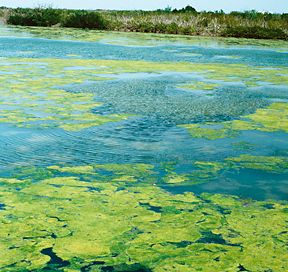algal bloom

An algal bloom leaves a green scum-like substance on the waters of the Indian River Lagoon, Florida, in the mid-1990s.
Algal bloom is a sudden spurt of algal growth that may be due to an abnormal amount of sunlight over a lengthy period or greatly increased amounts of phosphorus or nitrogen entering the aquatic ecosystem from sewage systems and agricultural fertilizers. Excessive growth of the algae causes destruction of many of the higher links of the food web. Algae that die and sink to the bottom at the end of the growing season stimulate massive growth of bacteria the following year, resulting in depletion of oxygen in the deeper water layers. This may result in fish kills and replacement with less valuable species who may be more tolerant of increased phosphorus levels. Deoxygenation also may cause chemical changes in the mud on the bottom, producing increased quantities of chemicals and toxic gases. All these changes further accelerate the eutrophication (aging) of the aquatic ecosystem.
